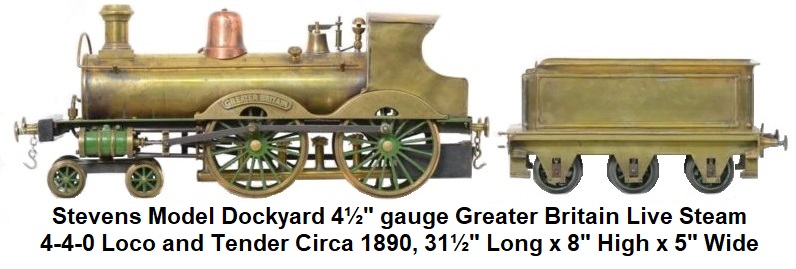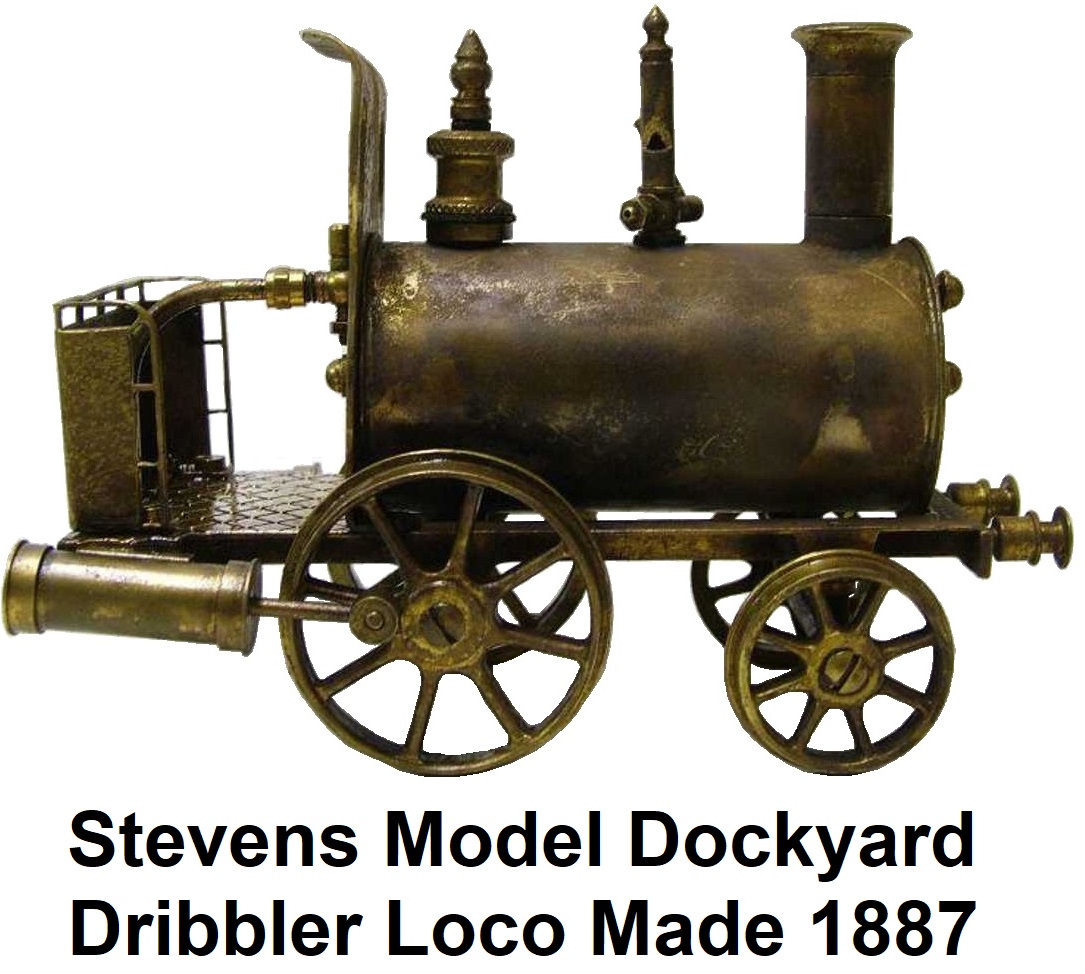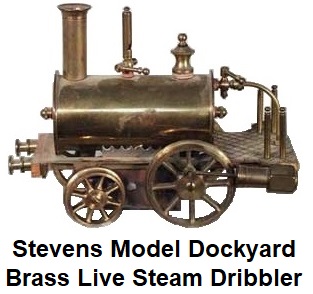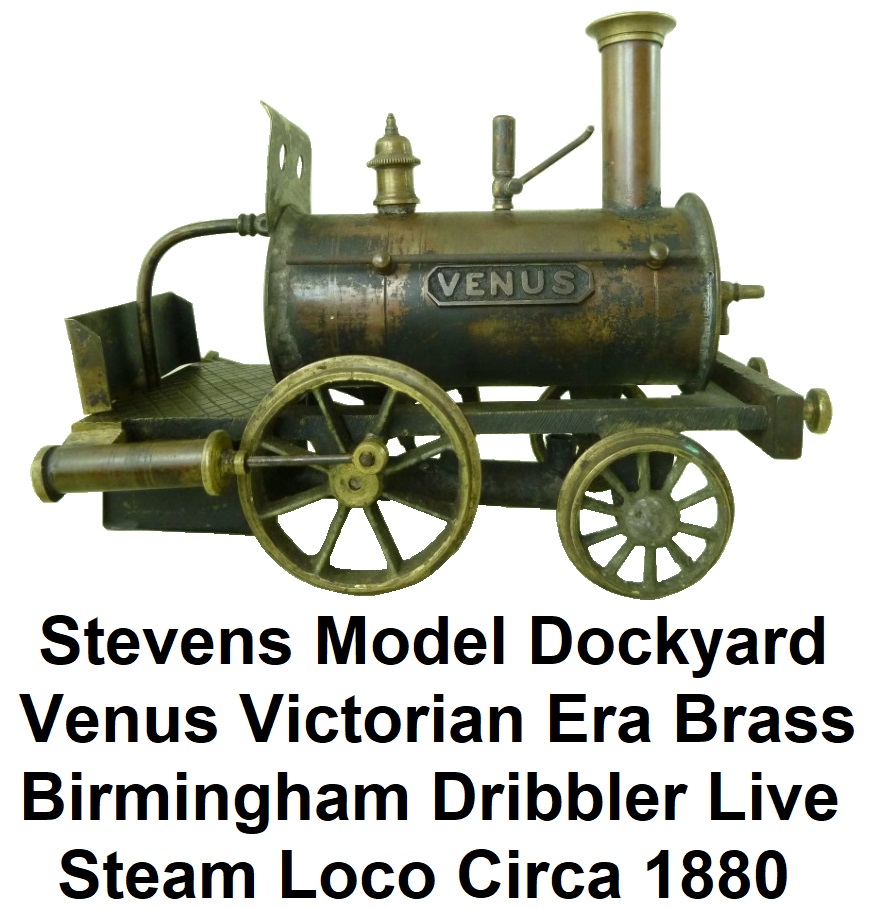 Stevens's Model Dockyard was established by William Stevens in 1843 in Aldgate, London England to produce mechanical
and scientific novelties. Though probably best known for their live steam 'Birmingham Dribbler Floor Locomotives' they
actually offered a vast selection for the modeling community, including steamship and steamboat models, sailboat models,
boat fittings, machine tools, marine engines, clockwork motors, electric motors, optical instruments, as well
as complete stationary steam driven power plants. They also sold Meccano, Klipit and other
branded items. Most of their products appear to have been made in the company's own workshops, but there may have been
some items brought in and rebranded. Several models of locomotives were offered as well as a selection
of rail cars and track to run them on. Little information is known about this company. After the death of William
Stevens in December 1899, the business was carried on by his sons.
Stevens's Model Dockyard was established by William Stevens in 1843 in Aldgate, London England to produce mechanical
and scientific novelties. Though probably best known for their live steam 'Birmingham Dribbler Floor Locomotives' they
actually offered a vast selection for the modeling community, including steamship and steamboat models, sailboat models,
boat fittings, machine tools, marine engines, clockwork motors, electric motors, optical instruments, as well
as complete stationary steam driven power plants. They also sold Meccano, Klipit and other
branded items. Most of their products appear to have been made in the company's own workshops, but there may have been
some items brought in and rebranded. Several models of locomotives were offered as well as a selection
of rail cars and track to run them on. Little information is known about this company. After the death of William
Stevens in December 1899, the business was carried on by his sons.
 Stevens’s Model Dockyard made and sold models, toys and parts for modellers and are often confused with the
original Model Dockyard or Clyde Model Dockyard companies that dealt in similar products. A great deal of controversy
has emerged in the collecting world as to which models now in existance were actually made by Stevens's Model Dockyard
or by the other companies making similar products. Stevens Model Dockyard spirit fired live steam locomotives were
either 2¾", 3¼" or 4½" gauge and made of brass. The 2¾" gauge trains were a more common scale used
during the Victorian era. Models included a 2-2-0 Venus, a 2-4-0 #293 Tank Loco, a 2-4-0 #294 Invicta tank loco,
a 4-4-0 #296 The Prince tender loco, a 4-4-0 Britania Tank and a 4-2-2 Bodicea model. Early engines were kept simple,
Stevens’s Model Dockyard made and sold models, toys and parts for modellers and are often confused with the
original Model Dockyard or Clyde Model Dockyard companies that dealt in similar products. A great deal of controversy
has emerged in the collecting world as to which models now in existance were actually made by Stevens's Model Dockyard
or by the other companies making similar products. Stevens Model Dockyard spirit fired live steam locomotives were
either 2¾", 3¼" or 4½" gauge and made of brass. The 2¾" gauge trains were a more common scale used
during the Victorian era. Models included a 2-2-0 Venus, a 2-4-0 #293 Tank Loco, a 2-4-0 #294 Invicta tank loco,
a 4-4-0 #296 The Prince tender loco, a 4-4-0 Britania Tank and a 4-2-2 Bodicea model. Early engines were kept simple,
 usually made of cast, machined and sheet formed brass, with a pair of oscillating cylinders driving the main wheels.
Wheel axles, shafts and pins were made of steel. These engines were basically a boiler
mounted on wheels, although simple decoration (usually bands of lacquer) was sometimes applied. They featured a
wooden front buffer block. The later engines produced were more sophisticated and featured slide valve cylinders
and a fair amount of detail.
usually made of cast, machined and sheet formed brass, with a pair of oscillating cylinders driving the main wheels.
Wheel axles, shafts and pins were made of steel. These engines were basically a boiler
mounted on wheels, although simple decoration (usually bands of lacquer) was sometimes applied. They featured a
wooden front buffer block. The later engines produced were more sophisticated and featured slide valve cylinders
and a fair amount of detail.
Birmingham Dribbler or carpet railway describes a type of very early model railway. It is a bit
of a misnomer, as the railway featured a model live steam railway locomotive, but no track – the locomotive was
simply run across the floor. In some cases, the front wheels were even made steerable so that the trains could be run
in a circle without track. Ironically, the cast brass wheels were flanged. Theses steam engines first appeared in
the 1840's and became very popular Victorian model railway toys.
The early spirit fired locomotives produced by Stevens Model Dockyard were often referred to as 'Birmingham Dribbler' types,
or as 'Piddlers'. This was due to the tendency of these steam engines to spray and leak water and drip steam residue
across the floor when running. For later model steam trains produced by Stevens Model Dockyard, track mounted on a wood
base and made of iron was included. It was provided in 20' radius circles. Rolling stock included polished mahogany
wood carriages, guard's vans, trucks, and a brake van.
The Stevens Model Dockyard 2-2-2 was released in 1890. Initially it was coal fired but later
versions were spirit fired. The loco measured 20 inches long by 7 inches wide and was 4½ inch gauge. It
featured a lever type safety valve, water level gauge, whistle, firedoor, water gauge tapes and forward/reversing gear.
The smoke box door opened to reveal the water tube boiler, steam line and exhaust pipes. A fully working regulator was
also fitted. The twin cylinders were double acting made from cast metal and fitted with working crossheads. The buffers
were spring loaded. The loco retailed in 1890 for 25.00. It could also be purchased with a tender which extended the
loco's length to over 30 inches. Like all dribbler locos, it could be run on the ground without track.
The company issued its final catalog in 1927/28 and the business closed after 80+ years in production. Items produced
by Stevens Model Dockyard are easily identifiable by the word 'Stevens' stamped in an arch shape on the underside,
usually accompanied by the year of manufacture.

